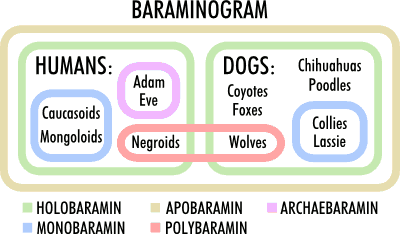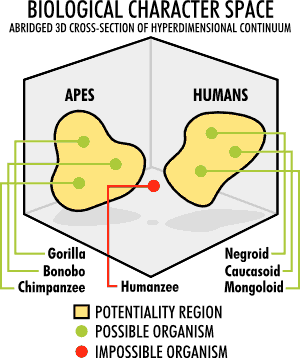OBJECTIVE:
Creation Education
OBJECTIVES:
OBJECTIVE: Ministries
Online Shop
It is part of our mission here at OBJECTIVE: Creation Education to bring understanding of Creation Science to the masses who are unable to learn about true science in the Secular controlled media and education systems. In this article, I will introduce to you a new advancement in Creation Science terminology that you will be seeing used more often in the future.
Creation Scientists often talk about kinds when referring both to the original creations of the Lord and those that were preserved from the Flood on Noah's Ark. Evolutionists attack this discussion by claiming that kinds is an undefined and loose term. To an extent, the Evolutionists have a point; the word kind, while understood perfectly by Creation Scientists when used in its Scriptural sense, can lead to confusion among the general audience due to its loose usage in non-technical speech. This confusion is what the Evolutionist unfairly takes advantage of when trying to disparage Creation Systematics, or the classifying of created organisms. Realizing this, Creation Scientists -- led in 1990 by Kurt P. Wise and Walter ReMine -- have developed a new terminological system whose goal is to aid both researchers in their research and the general population in its understanding of Creation Science findings. This new system is called Baraminology.
Baraminology is based on the concept of the baramin, a term that is synonymous with the Biblical kind. The word barmin was coined in 1941 by Frank Lewis Marsh from the Hebrew words bara (create) and min (kind). A baramin is a group of organisms -- those both known and unknown to science and both extant and extinct -- who share a genetic relationship through common descent from an organism originally created by the Lord during the Creation Week. For instance, humans are a baramin that includes all the known races (and any obscure or extinct races) which originated via genetic descent from the offspring of Adam and Eve.
Baraminology lets us discuss clearly the Creation model of the diversity and diversification of life. This model is termed Discontinuity Systematics. Unlike the incorrect Evolutionist model that supposes that life forms a continuous lineage from Mushroom to Monkey to Man, the Creation model -- supported by science and the Bible -- shows that the pattern of life is marked first and foremost by discontinuity. When we step back and look at all the life on the planet, it is clear that we can group the various species into distinct baramins, and that the spaces between these baramins are discontinuities that no amount of Evolutionist fantasizing can bring together. Humans (one baramin) do not form a continuity with apes (another baramin).
To help us further in our goal of clear understanding of the Lord's Creation, we may also employ more specific baraminological terms, as illustrated in the following example baraminogram:

Unlike the racist philosophy of Evolutionism which holds that the tribes of Man are diverging into different unhuman species, Creation Science shows that a Human will always be a Human (and a dog always a dog) and baraminology is used to express this finding. The holobaraminic barrier is inviolable as it is the only natural division that represents the hand of God and not the destructive force of post-Fall entropy. Apobaramins, monobaramins, and polybaramins are all artificial groupings that were coined for practical purposes such as ecological studies and farm management. |
In order to determine if a given group of organisms form a holobaramin or if they are monobaraminic, baraminic demarcation must be evaluated. This process involves four foundational concepts (definitions taken from "A Refined Baramin Concept", Wood et al., 2003 Baraminology Study Group.):

Therefore, the discrete, divine creation of a given organism -- and hence the existence of God -- can be proved mathematically simply by using Dembski transformations in biological character space to derive the ReMineian tensor (which is beyond the scope of this overview article).
In order to expand on the work of Marsh, Wise, and ReMine and apply baraminology to my own field of expertise -- searching for the Lord's hidden creations -- I am proposing a new baraminological term: Cryptobaramin.
A cyrptobaramin is a holobaramin that is currently hidden from Mankind. By hidden, I mean that members of the baramin in question have not been seen since some time after the Flood by all but a very few people, if any. Notable examples include the pterosaurs (the saraph), sauropods (of the Behemoth apobaramin), and plesiosaurs (Leviathans).
Expanding on this systematic innovation further, a cryptomonobaramin is a group of organisms within a holobaramin that have become separated from their kin after the Flood and lost to Man's knowledge. For example, the yeti is a cryptomonobaramin of the ape holobaramin.
An individual member of a cryptobaramin or cryptomonobaramin is known as a cryptid -- a term already current among cryptozoologists, and which will be adopted by what should from hereon be known as cryptobaraminologists.
Cryptobaramin and cryptomonobaramin are provisional terms: a cryptobaramin can become a holobaramin, and a cryptomonobaramin a monobaramin, if the baramins in question are brought into the light of Man's knowledge with full scientific documentation. For example, it is the hope of Project Pterosaur to one day turn pterosaurs from a cryptobaramin into a holobaramin (or an apobaramin, should evidences show multiple pterosaur holobarmins).
(The derived terms cryptoapobaramin and cryptopolybaramin may also be used to describe their respective cryptobaraminological situations. Take note though: both terms should only be used when all members of the groups are cryptobaraminic in nature; if there are any members that are not hidden, then the terms semicryptoapobaramin and semicryptopolybaramin should be employed to avoid confusion.)
Lastly, unlike Secular species concepts that require physical specimens of the "species" for proper classification, baraminology can encompass cryptobaramins that are known only through scriptural exegesis. Thus we can discuss whether the Biblical reem (more popularly known as a "unicorn") is a cryptomonobaramin of the horse holobaramin, or if it represents the cryptobaramin known as ceratopsia, which includes the more genetically decadent triceratops. This puts baraminology well ahead of competing Secular systematics.
As you can see, the Evolutionist canard that Creation Systematics is based on an undefined term is entirely false. In this short article alone, we see defined fourteen terms that Creationist Scientists regularly use to classify organisms according to the Biblically sound Creation model (and I have proposed an additional seven terms that will undoubtedly be soon adopted).
To learn more about baraminology: